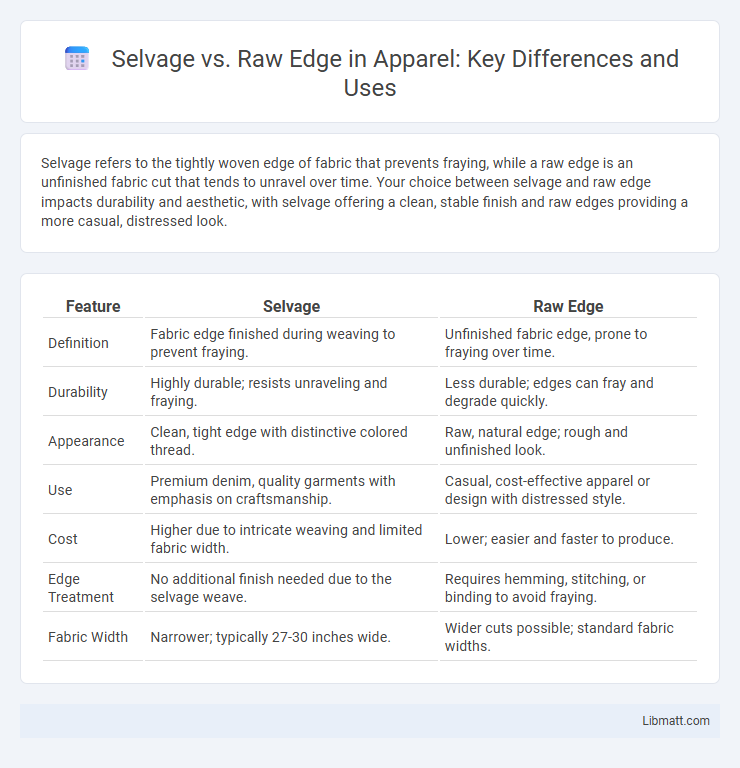Selvage refers to the tightly woven edge of fabric that prevents fraying, while a raw edge is an unfinished fabric cut that tends to unravel over time. Your choice between selvage and raw edge impacts durability and aesthetic, with selvage offering a clean, stable finish and raw edges providing a more casual, distressed look.
Table of Comparison
| Feature | Selvage | Raw Edge |
|---|---|---|
| Definition | Fabric edge finished during weaving to prevent fraying. | Unfinished fabric edge, prone to fraying over time. |
| Durability | Highly durable; resists unraveling and fraying. | Less durable; edges can fray and degrade quickly. |
| Appearance | Clean, tight edge with distinctive colored thread. | Raw, natural edge; rough and unfinished look. |
| Use | Premium denim, quality garments with emphasis on craftsmanship. | Casual, cost-effective apparel or design with distressed style. |
| Cost | Higher due to intricate weaving and limited fabric width. | Lower; easier and faster to produce. |
| Edge Treatment | No additional finish needed due to the selvage weave. | Requires hemming, stitching, or binding to avoid fraying. |
| Fabric Width | Narrower; typically 27-30 inches wide. | Wider cuts possible; standard fabric widths. |
Introduction to Selvage and Raw Edge
Selvage is the tightly woven, finished edge of fabric that prevents unraveling, often characterized by a distinct pattern or text indicating the manufacturer. Raw edge refers to the unprocessed, cut edge of fabric that lacks any finishing, making it prone to fraying and damage. Understanding the difference between selvage and raw edge is essential for sewing techniques, fabric stability, and design decisions.
Defining Selvage: What It Is
Selvage refers to the tightly woven edge of a fabric created during the manufacturing process to prevent unraveling and fraying. This durable border runs parallel to the warp threads, providing a firm structure and often displaying manufacturer information or fabric patterns. Unlike raw edges, which are cut and fray easily, selvage edges maintain fabric integrity throughout use and handling.
Understanding Raw Edge: Key Features
Raw edge fabric features an unfinished border that is prone to fraying and unraveling over time, making it less stable than selvage edges. This edge exhibits visible loose threads, requiring additional finishing techniques like hemming or binding to prevent damage. Understanding raw edge properties is essential for fabric handling in sewing projects to ensure durability and clean results.
Differences Between Selvage and Raw Edge
Selvage refers to the tightly woven strip on fabric edges designed to prevent fraying, characterized by a clean, finished look and often containing manufacturer information or patterns. Raw edge fabric lacks this reinforced border, making it prone to unraveling and requiring hemming or finishing for durability. Understanding the differences between selvage and raw edge can help you choose the right fabric edge treatment for your sewing or crafting projects to ensure durability and aesthetic appeal.
The Manufacturing Process of Selvage vs Raw Edge
Selvage fabric is created using traditional shuttle looms, producing tightly woven, finished edges that prevent fraying and add durability. Raw edge fabric results from modern cutting techniques on power looms, leaving the edges unfinished and prone to unraveling over time. The manufacturing contrast between shuttle looms for selvage and power looms for raw edge significantly impacts fabric quality and longevity.
Aesthetic Impact: Selvage vs Raw Edge Styles
Selvage edges provide a clean, finished look with tightly woven, durable borders that prevent fraying, enhancing the garment's overall aesthetic appeal and perceived quality. Raw edges offer a more casual, rugged style characterized by intentional fraying and unfinished seams, contributing to a trendy, deconstructed appearance popular in contemporary fashion. The choice between selvage and raw edge significantly influences the garment's visual texture and perceived craftsmanship, with selvage evoking precision and raw edges conveying a laid-back, edgy vibe.
Durability and Longevity Comparison
Selvage fabric features tightly woven edges that prevent fraying, significantly enhancing durability and longevity compared to raw edges, which are prone to unraveling without proper finishing. Your garments made with selvage fabric maintain structural integrity through multiple washes and wear, making them ideal for long-lasting projects. Raw edges require additional hemming or sealing to achieve similar durability, often reducing the lifespan of the fabric.
Common Uses for Selvage and Raw Edge
Selvage fabric is commonly used in high-end denim and upholstery for its clean, finished edges that prevent fraying and add durability. Raw edges frequently appear in casual fashion, quilting, and artistic projects where a frayed or textured look enhances the design. Your choice between selvage and raw edge depends on the desired aesthetic and functional requirements of your sewing or crafting project.
Care and Maintenance Tips
Selvage fabric, characterized by its tightly woven edge, resists fraying and requires minimal finishing, making it easier to maintain with gentle washing and air drying. Raw edge fabric demands extra care, such as overlocking or using fabric sealants to prevent unraveling, and should be handled delicately during washing to preserve its integrity. Understanding the differences helps you choose the best methods to keep your fabric looking pristine and durable over time.
Which to Choose: Selvage or Raw Edge?
Choosing between selvage and raw edge depends on your sewing project and fabric type; selvage offers a tightly woven, finished edge that prevents fraying, making it ideal for visible seams and quilting. Raw edges provide flexibility for fabric manipulation, but require additional finishing techniques like serging or hemming to avoid unraveling. You should consider the durability needed and the aesthetic effect to determine whether the clean stability of selvage or the adaptability of raw edges best suits your project.
Selvage vs raw edge Infographic

 libmatt.com
libmatt.com